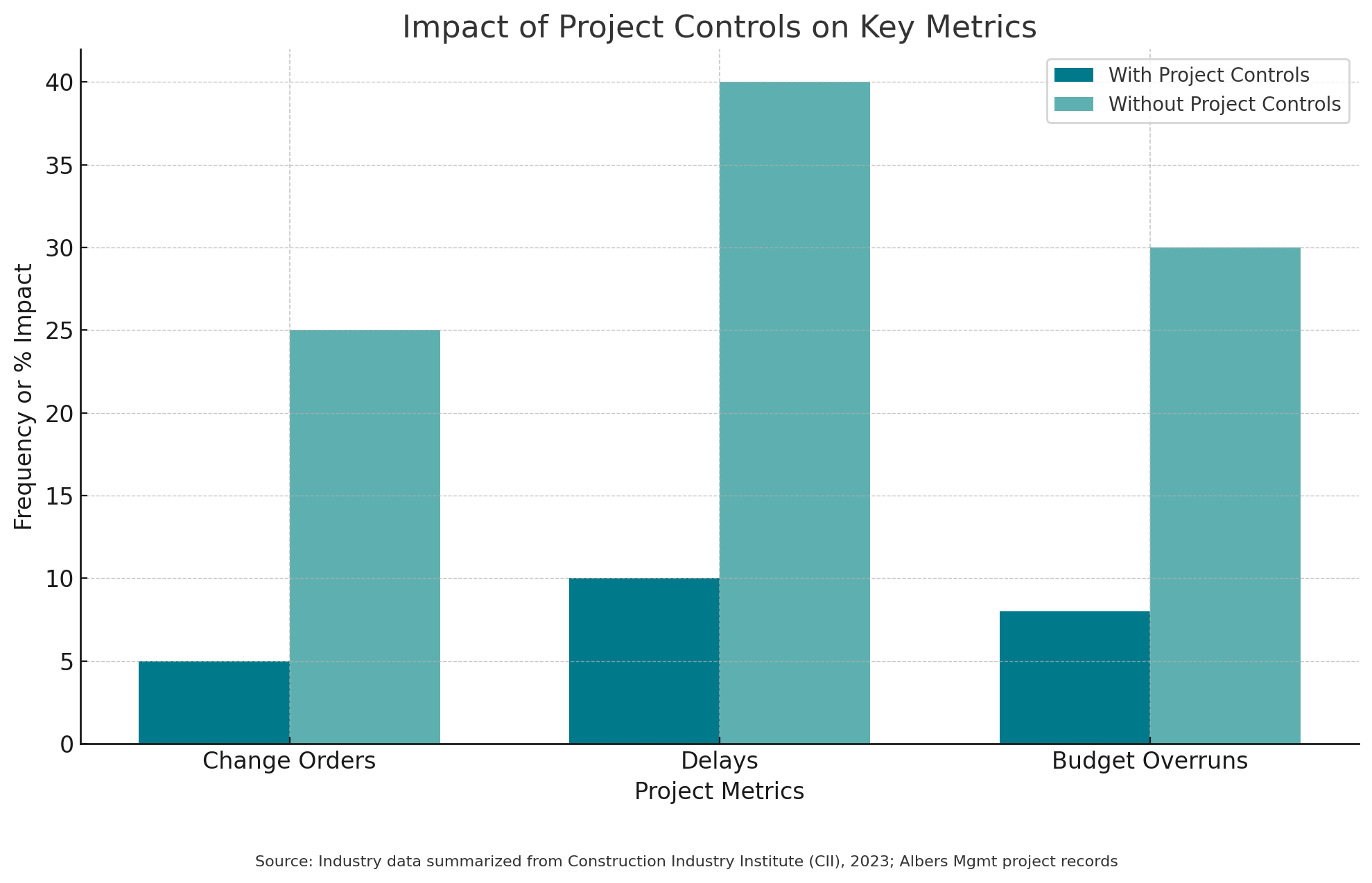What Are Project Controls?
Mastering Project Controls – Series Part 1 (PC-001)Introduction
Project controls are the backbone of successful capital delivery. They integrate scope, cost, schedule, and risk into one aligned system, empowering teams and owners to deliver with confidence. But despite their impact, many still ask: what exactly are project controls? This article, the first in Albers Management’s Mastering Project Controls series, defines them, explores their core components, and shows why they’re non-negotiable for any well-run capital program.
Defining Project Controls
Project controls refer to the systematic processes and tools used to manage, measure, and align the three core pillars of project success: scope, cost, and schedule. At its essence, project controls exist to track performance, flag variances, and proactively guide corrective action. This enables teams to deliver on expectations—before surprises derail the mission.
Why Project Controls Matter
Project controls don’t just create reports—they create clarity. In high-risk environments, poor decisions often stem from poor data. With controls in place, decisions are grounded in reality, and early signals become course corrections instead of costly rework. Strong controls:
- Reduce change order exposure
- Improve stakeholder alignment
- Enable better cash flow planning
- Support board-level governance and reporting
The Core Disciplines of Project Controls
A full controls system integrates these key areas:
- Scope Control
- Cost Control
- Schedule Control
- Change Management
- Risk Management
- Document Control
- Reporting & Governance
Integrated vs. Fragmented Controls
Fragmented controls—where scope, cost, and schedule are managed separately—create risk. Teams work in silos, information is delayed, and trends are missed. Integrated controls unify all data streams into a common environment, giving project leaders the insight to act early and decisively.
Owner's Perspective: Why It Matters
For owners, project controls mean visibility, accountability, and confidence. They provide the foundation for investment-grade reporting, design coordination, and informed decision-making. They reduce risk and support better outcomes for users, communities, and bottom lines.
The Albers Approach to Project Controls
At Albers Management, we don’t bolt project controls on—we build them in. Our controls philosophy begins during business case development and continues through closeout. We help clients:
- Right-size their controls systems based on risk and complexity
- Select and configure the right tools (Primavera, Power BI, Procore, SmartPM, etc.)
- Build dashboards that board members actually use
- Establish governance structures that balance control with flexibility
Looking Ahead in the Series
This series will explore each control type in depth—starting with Scope Control, Schedule Control, and Cost Control. Each post will break down how these controls work in practice, what tools support them, and what owners need to watch out for when they’re missing or poorly applied.
Ready to build a stronger controls framework for your next capital program? Let’s talk.
Upcoming Posts in the Mastering Project Controls Series
Foundational
| Post Title | Short Description |
|---|---|
| Scope Control | How to keep project scope aligned and avoid scope creep. |
| Schedule Control | Techniques to manage timelines and prevent delays. |
| Cost Control | Tracking budgets and managing expenditures effectively. |
| Change Management | Controlling scope, cost, and schedule impacts from change. |
| Document Controls | How to structure, share, and safeguard project data. |
| Risk Management | Identifying, analyzing, and mitigating project risks. |
| Reporting & Governance | Reporting frameworks that build trust and ensure compliance. |
Advanced
| Post Title | Short Description |
|---|---|
| Earned Value Management (EVM) | Integrating schedule and cost to track performance. |
| Forecasting & Trending | Using data to project future performance and outcomes. |
| Quality Control & Assurance | Ensuring deliverables meet expectations and standards. |
| Procurement & Contract Controls | Managing external vendors, terms, and obligations. |
| Integrated Master Scheduling | Aligning all schedules into a single master timeline. |
| Commissioning & Turnover Controls | Ensuring a smooth handoff to operations. |
| Configuration & Requirements Management | Controlling evolving requirements across stakeholders. |
| Interface Management | Coordinating across disciplines and contract boundaries. |
| KPI & Performance Metrics | Establishing metrics that actually drive outcomes. |
| Resource Planning | Planning and tracking workforce, equipment, and material needs. |
| Claims Prevention & Dispute Resolution | Minimizing conflicts through proactive controls. |
Cornerstone
| Post Title | Short Description |
|---|---|
| Complete Guide to Project Controls | The comprehensive reference for construction and infrastructure controls. |
Want a deeper, behind-the-scenes perspective?
Read the personal blog version by David Gray:
What Are Project Controls? – DavidGrayProjects.com
About the Author
David Gray is a principal at Albers Management and a national expert in capital program delivery. With experience managing over $20B in complex infrastructure and healthcare projects, he leads with strategy, structure, and service.
Outside of Albers, David shares long-form insights and behind-the-scenes lessons at DavidGrayProjects.com, where he writes about project strategy, leadership, and the future of infrastructure.
Visit DavidGrayProjects.com →
